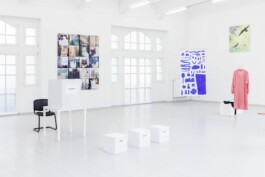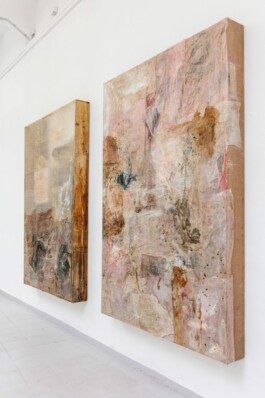Interview mit
Judith Miriam Escherlor
Judith Miriam Escherlor, Artist Talk
Tanja Heuchele: Your life without art would be…
Judith Miriam Escherlor: I think it’s very difficult to realistically imagine oneself on a completely different path. I don’t know who I’d be if I didn’t do what I do. And it’s not as if art suddenly came into my life and there was a before and an after, a defining point. I think it has always been with me and I cannot imagine life without it, just as I cannot imagine never again reading a book or drinking a glass of water.
TH: What material inspires you the most? And which materials are you working with most at the moment?
JME: I love hair of all sorts; right now I am working with human hair, and the evocations are fascinating. Cat hair, of course, is also beautiful. And I seem to always come back to textiles. Both materials are about the everyday and the intimate, the banal and the profound. And I just love looking and touching.
TH: Are there also materials that you would never use again?
JME: Working with nail polish probably cost me a few brain cells, so maybe nail polish. But it’s so tempting.
TH: What is your work about? What is your intention with it? What should it evoke in the viewer’s emotion?
JME: My work in the current exhibition is a block of upholstered portraits of cats looking out of their windows. How people respond to it might depend on whether they like cats, if they are willing to look closely at the cats and think about their situation and let the cats look back at them, or if they just see the cats as something to look at while they walk past. Like any portrait, the cats' faces can intrigue you or leave you unmoved. Looking at someone’s face and into someone’s eyes immediately establishes a kind of intimacy; you begin to imagine their characteristics and their story.
TH: When did the journey with Who’s afraid of_Rosa begin for you and what keeps you involved?
JME: I have been part of this project since its origin in 2018/19. The group of artists, as well as the project itself, is constantly changing and evolving. It’s a very large group to work with, especially since we are almost never in the same place at the same time, and I think we are still very much at the beginning of our journey together. I’m excited about the exhibition we have created at a&o Kunsthalle because I feel that the project is revealing more of its true potential. This is a great place to move forward from.
The Artist, Judith Miriam Escherlor

Judith Miriam Escherlor, Artist Talk
TH: How is the collective Who’s afraid of_Rosa organized? So far, I’ve only met female Rosa’s… can men also be part of it?
JME: The collective was formed by members of the Women Artists Network Leipzig, but we have had male collaborators involved in some of the artworks.
TH: The subline of the exhibition is public space – private space – political space. What space do you (not) feel comfortable in? Where would you like to make a difference? What is your perception of space? Is it even the case that the above-mentioned spaces do not exist without each other?
JME: I feel extremely privileged to be able to move freely in and between all of these spaces. It is a quality of the society I live in that allows all individuals to express themselves without fear of being sanctioned. Even when there are restrictions, we are able to name them and talk about them. This is not true for all places. Who’s afraid of__Rosa attempts to bridge the gaps between places of freedom and restricted freedom. Public, private, and political spaces have a lot of overlaps, and sometimes they are indiscernible. When you are fighting for one, you are usually also fighting for another.
TH: How do you react to people who are not familiar with art, and how do you think they can be made to understand better?
JME: People need to let go of the fear that they are not able to understand art correctly. Of course, looking at art and understanding it is something you can learn and refine. But every person has their own way of perceiving the world around them and reacts in a way that is unique and appropriate to them. I think good art is accessible on a level at which you don’t need to know anything about it. It speaks to you and provokes an immediate emotional response. Then you can peel back the layers, find out about the process, the story, the context.
TH: What do you enjoy about your life as an artist?
JME: Learning new things by exploring different media and being surprised by the outcome. You never know what’s around the corner and sometimes what you find is like a whole new world with unknown possibilities. Working intensely on a project is very rewarding; I guess that’s what you call being in the flow. I also enjoy working with others. Lately, I have been collaborating with other artists in my artwork as well as in exhibition projects, like Who’s afraid of__Rosa, and, again, it opens up so many new perspectives and opportunities.
TH: What about your next projects, exhibitions? Where can you be seen next?
JME: At Galerie Intershop in Leipzig, and hopefully touring with Who’s afraid of__Rosa and other collaborative projects.
Judith Miriam Escherlor, Exhibition View, 2021

Siehe auch
Mehr Interviews




